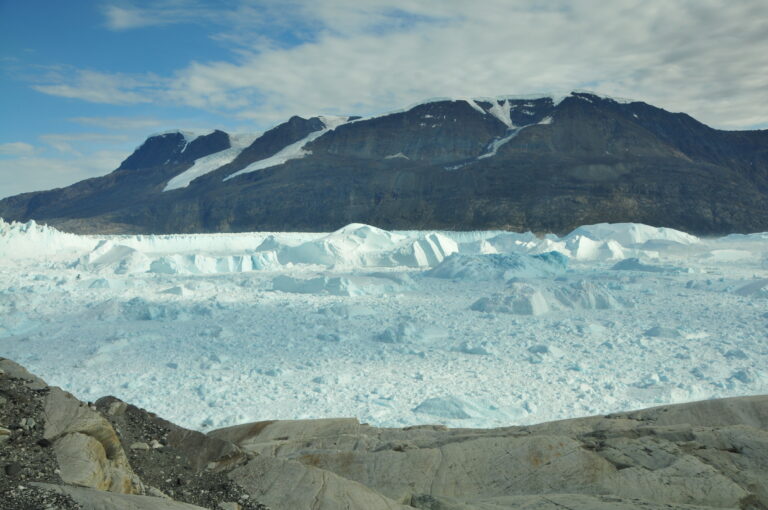Project Description
Ice mélange is the mixture of icebergs and sea ice found near the termini of tidewater glaciers (Amundson et al., 2020). In locations such as Greenland, where tidewater glaciers flow into narrow fjords, the ice mélange matrix can become rigid as friction from the valley sides increases, which induces a buttressing force on the glacier. The formation of ice mélange at the margins of the Greenland Ice Sheet (GrIS) therefore has implications for future ice sheet stability and sea level change. Furthermore, the variability in ice mélange conditions and the extent to which it covers the open ocean significantly impacts the fjord biogeochemistry (Hopwood et al., 2018) and subsequently Arctic marine ecosystems. It is therefore crucial to understand how changes in ice discharge is impacting ice mélange formation around Greenland to understand it’s cascading impacts on marine biodiversity.
This project will harness high resolution satellite data sets and Artificial Intelligence (AI) techniques to quantify how spatial and temporal variability in ice mélange impacts marine ecosystems in Greenland. This will be completed by tackling 3 objectives:
1) Map ice mélange variability around the margins of the GrIS using AI segmentation methodologies.
2) Quantify the spatial and temporal variability in ice mélange conditions in response to variations in ice discharge.
3) Investigate the role of ice mélange variability in driving marine ecosystem change across the margins of the GrIS.
There are few studies developing satellite data for systematic monitoring of ice mélange (Cassotto et al., 2015). This project will develop techniques to automatically map the extent and conditions of ice mélange around the margins of the GrIS e.g. using Convolutional Neural Networks (CNNs) applied to Sentinel-1/2 data. Initially, the technique will be developed on a few well studied sample sites (e.g. Helheim Glacier, Jakobshavn Isbrae) and the performance of the techniques assessed using validation data. Simple metrics such as the extent and concentration of ice in the fjords plus the timing of break-up events will be investigated. Other parameters, such as the velocity of the mélange matrix, may also be studied.
The conditions, extent, and temporal variability in ice mélange will next be related to rates of ice discharge from the GrIS using open-source data repositories of ice fluxes and velocities. This will be used to investigate the physical process of ice mélange formation and variability over seasonal timescales. This analysis will then be used to infer how changes in ice discharge and subsequently ice mélange variability impacts marine ecosystems. In particular, changes in primary productivity within fjords and in the open ocean will be assessed using satellite mapping of chlorophyll and related to the ice mélange mapping products. The relationship between primary productivity and fjord freshening due to ice mélange variability will be assessed through statistical analysis (e.g. PCA). There may be opportunities for fieldwork as part of this project to collect primary data on ecosystem change within fjord environments.
CANDIDATE BACKGROUND
Essential Criteria:
- Applications are encouraged from applicants with a degree (minimum 2:1) in: physical geography, environmental science, remote sensing, physics, computer science, data science, marine science, GIS, and related disciplines.
Desirable criteria include:
- Knowledge in one or more of the following would be beneficial: deep learning (e.g. CNNs), data science and statistics, satellite remote sensing processing/analysis, glacier/sea ice/ice mélange physics, oceanography, marine ecosystem, and/or Arctic environmental change
- Some knowledge/experience in applying deep learning/AI algorithms to data (e.g. using TensorFlow, Sci-Kit Learn).
- Programming experience (e.g. Python, Matlab) as well as knowledge and experience working with complex data sets (e.g. from remote sensing).
- Demonstrable experience working in an interdisciplinary team is considered advantageous.
Photo credit: Leigh Stearns, University of Kansas.
Supervisors
William HarcourtPrimary Supervisor: | Profile: William Harcourt Email: william.harcourt@abdn.ac.uk Institution: University of Aberdeen Department/School: School of Geosciences |
Jennifer McKinleySecondary Supervisor: | Profile: Jennifer McKinley Email: j.mckinley@qub.ac.uk Institution: Queen's University, Belfast Department/School: School of Natural and Built Environment |
Ursula WitteAdditional Supervisor: | Profile: Ursula Witte Email: u.witte@abdn.ac.uk Institution: University of Aberdeen Department/School: School of Biological Sciences |
Additional Supervisor: | Prof. Leigh Stearns, University of Kansas |
References
Amundson, J.M., Kienholz, C., Hager, A.O., Jackson, R.H., Motyka, R.J., Nash, J.D., Sutherland, D.A. (2020). Formation, flow and break-up of ephemeral ice mélange at LeConte Glacier and Bay, Alaska, Journal of Glaciology, 66, 577-590
Cassotto, R., Fahnestock, M., Amundson, J.M., Truffer, M., Joughin, I. (2015). Seasonal and interannual variations in ice melange and its impact on terminus stability, Jakobshavm Isbræ, Greenland, Journal of Glaciology, 61, 76-88
Hopwood, M.J., Carroll, D., Browning, T.J., Meire, L., Mortensen, J., Krisch, S., Achterberg, E.P. (2018). Non-linear response of summertime marine productivity to increased meltwater discharge around Greenland, Nature Communications, 9, 1-9
QUADRAT Themes
- biodiversity
- earth-systems






















































